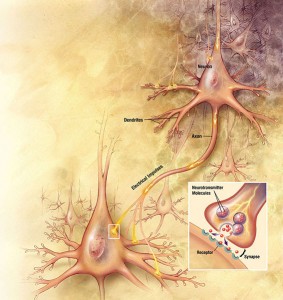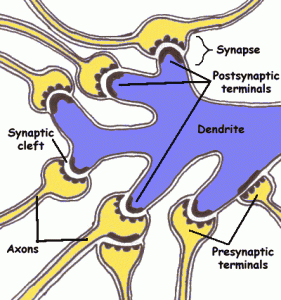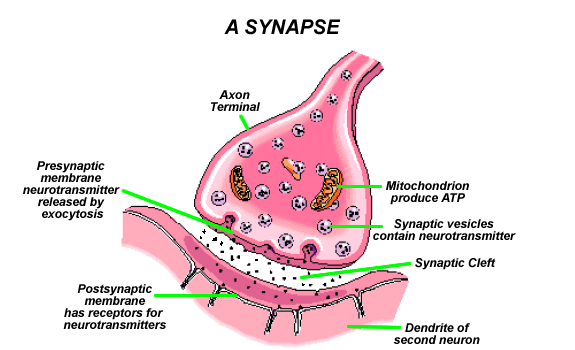Neuroplasticity in Brief
Hey guys,
For my first post on this blog, I’ve decided to write about the brain makes structural and functional changes. This topic is important because understanding neuroplasticity gives you a biological insight into things like memory consolidation, intelligence, cognitive training, education, and subliminal priming.
In general there are two broad areas of neuroplasticity, structural plasticity, ie the changing of various brain structures, and functional plasticity, or changes in the brain that yield different brain activity patterns. These are inextricably linked to one another: structural changes of different sizes yield various kinds of changes in activation.
Since I’ll cover how functional changes happen in a future synaptic microcircuits post, I’ll be covering basic structural plasticity today. I’ll be starting with the largest expressions of neuroplasticity and make my way down to the smaller levels. The largest scale examples of neuroplasticity are those that can be detected using magnetic resonance imaging, or MRI. Using MRI, scientists can physically measure the size of various parts of a person’s brain and they can use this tool to measure how different brain areas change in size over time. One method of doing so goes like this: a group of subjects undergo some sort of training, like meditation training for 8 weeks, and their brains are measured with MRI before and after the training. When compared to how the non trained control subjects brains changed between the pre and post session MRI, the meditation trained subjects demonstrate significant changes to the size of various regions.
This means that to a certain degree, our brains are responsive to experiential changes. But saying that brain’s are plastic in the face of environmental changes to a certain degree really underplays the amount to which our brains can change. Once you have insight into neuroplasticity on the cellular level, you can imagine just how much restructuring is going on in order to cause a change on the scale of a millimeter increase in a brain region.

What is it that’s happening on the level of neurons that is causing these changes? Well there’s a lot of ways that neurons can change. For starters, neurons could strengthen their mutual connection. This could take place by increasing the number of axons projecting to a specific cell or increasing the number of synapses on a given axon. Neurons can also change the number of cells they are connected to, as we get older, our brain  undergoes many changes, one of the significant changes that happen is our neurons stop connecting to so many other neurons and strengthen the connections that remain. So large regional changes could happen through many individual neurons breaking off connections in one region and strengthening connections in another. For example, string instrument players have a larger left hand representation on the motor cortex due to the amount of time they practice using their left hand to play different notes. Rather than their left hand representation merely being larger, it actually creeps into the area that would normally be reserved for the face. In order for that to occur, a lot of changes have to happen. As we can extrapolate from what I’ve described above, certain neurons would get new connections and sever old ones. One possibility is that the left hand neurons would become strongly connected to some of the nearby face neurons. These nearby face neurons would then cease firing with their previous neural population and begin firing with their new group, the left hand neurons. This is one possibility of how certain representative areas encroach on others.
undergoes many changes, one of the significant changes that happen is our neurons stop connecting to so many other neurons and strengthen the connections that remain. So large regional changes could happen through many individual neurons breaking off connections in one region and strengthening connections in another. For example, string instrument players have a larger left hand representation on the motor cortex due to the amount of time they practice using their left hand to play different notes. Rather than their left hand representation merely being larger, it actually creeps into the area that would normally be reserved for the face. In order for that to occur, a lot of changes have to happen. As we can extrapolate from what I’ve described above, certain neurons would get new connections and sever old ones. One possibility is that the left hand neurons would become strongly connected to some of the nearby face neurons. These nearby face neurons would then cease firing with their previous neural population and begin firing with their new group, the left hand neurons. This is one possibility of how certain representative areas encroach on others.
So we’ve covered that neurons increase and decrease their connections to other neurons and that these changes can have profound functional effects, but we haven’t looked at probably the most significant source of neuroplasticity: synaptic plasticity. Synaptic plasticity happens whenever a neuron connects to a new neuron, or removes its connection to a neuron, in fact the previous topic I just discussed needs to have synaptic plasticity otherwise it doesn’t work at all. The important thing here is that synapses can remain in place yet still conjure an enormous number of changes just by the different ways they can alter their function.
 Probably the most general way that synapses can change is that they can change the amount of signal they are sending to the neighboring cell. They do this by 1) changing the number of active sites on the synapse. Active sites are the spots on the synapses where the vescicles release their neurotransmitters into the synaptic cleft. 2) Synapses can change the number of neurotransmitters in each vescicle. The more neurotransmitters per vescicle, the longer the neurotransmitter receiving neuron stays firing. 3) Synapses can change the number of neurotransmitter reuptake receptors they have, the neurotransmitters are taken out of the synaptic cleft by these reuptake receptors. Therefore if you decrease the number of reuptake receptors you increase the time which the neurotransmitters have a chance to cause a post synaptic potential in the receiving neuron. And 4) synapses can change the number of calcium channels they have. Calcium causes the vescicles to fuse to the synaptic wall and release their neurotransmitters, therefore if you increase the number of calcium receptors you increase the concentration of calcium in the synapse and therefore increase the likelihood of vescicles releasing their neurotransmitters.
Probably the most general way that synapses can change is that they can change the amount of signal they are sending to the neighboring cell. They do this by 1) changing the number of active sites on the synapse. Active sites are the spots on the synapses where the vescicles release their neurotransmitters into the synaptic cleft. 2) Synapses can change the number of neurotransmitters in each vescicle. The more neurotransmitters per vescicle, the longer the neurotransmitter receiving neuron stays firing. 3) Synapses can change the number of neurotransmitter reuptake receptors they have, the neurotransmitters are taken out of the synaptic cleft by these reuptake receptors. Therefore if you decrease the number of reuptake receptors you increase the time which the neurotransmitters have a chance to cause a post synaptic potential in the receiving neuron. And 4) synapses can change the number of calcium channels they have. Calcium causes the vescicles to fuse to the synaptic wall and release their neurotransmitters, therefore if you increase the number of calcium receptors you increase the concentration of calcium in the synapse and therefore increase the likelihood of vescicles releasing their neurotransmitters.

Synapses can also change what kind of neurotransmitter they are using. This is critical because on one axon you could see both excitatory and inhibitory synapses innervating the same cell. This means that one synapse, the excitatory synapse, is bringing the cell closer to firing while the another inhibitory synapse is preventing it from firing. That brings up the question: why would anyone want to do that? Seems like a waste of energy. I’m gonna be getting into this topic a lot more in depth in my microcircuits video, but basically, putting both excitatory and inhibitory synapses on the same neuron but in different spots allows for a unique type of micromanagement of the way that the receiving neuron fires. This happens in our visual cortex and scientists have found out that it is both essential to our ability to process stimuli and they’ve found a couple interesting ways to mess with this visual system in such a way to make us see things that aren’t actually there.
So we’ve covered neuroplasticity on three levels so far: 1) regional changes, 2) neuron-level changes, and 3) synaptic changes.
Now that you understand a bit about what kind of neuroplasticity exists in the brain, I want to briefly cover some other aspects of this topic. For starters, lets look at why the brain needs to be economical with where its neurons connect to one another. If a neuron added a lot of connections without removing any, it would basically be a dead end of activity. You might ask, why would that happen, it would make more sense that if a neuron connects to more neurons, that’s just more neurons that it will cause to fire. This isn’t true because when a neuron creates an action potential, the membrane potential moves down the axons and divides at every branching point. Take a look at this example: if this neuron were to try and get this one to fire, it would be able to do so relatively easily because the action potential from this neuron would come through strongly. But if you have an arrangement that looks something like this: causing this first neuron to fire won’t do anything because as the membrane potential continues to divide down repeatedly as it travels down these axons, the signals either become lost or are extremely weak when they reach the postsynaptic neuron. If this neuron is actually trying to get any of these neurons to fire, he’d be best off cutting his connection from some of these other neurons and strengthen the ones that remain.
To a certain extent this process of cutting down the number of neuronal connections and strengthening the remaining ones is one of the most significant neural changes that happens in the maturing human brain. When we’re toddlers, our brain has many more synaptic connections than we do now. As we get older, many of these connections are removed and the ones that remain are strengthened significantly. This is part of the fascinating way that our brain allows us to adapt to our surroundings.
I hope you enjoyed my brief overview of how neuroplasticity works. This post was adapted from a YouTube video I posted a few months back.
Hope you enjoyed it,
Aki







5 Responses
12:07 pm
[…] There’s an interesting, short article at cognitivephilosophy.net about how the brain makes changes to its own structure and functions. […]
5:12 pm
Dear Dr. Boylston:
Finally, a non-regurgitative writer. I have a Google Alert with “Neuroplasticity” shows up on the web. Almost all posts/articles on this subject are people writing about what people are writing about.
You are able to effectively translate the complex to simplicity. I like how you summarize every couple of paragraphs before moving on.
My neurologist introduced me to neuroplasticity as a pain management tool after 4 back surgeries left me with flat back syndrome and its complications.
I found it to be obvious that pain/depression accompany each other. This led me to Positive/Cognitive/Behavioral Psychology. My goal is to enhance/optimize my mental psychological side with the hopes that the physical may tag along. In other words replacing depressive behavior with the positive so I can really “move forward”.
Now if I can only find a blogger with your same approach to address my wife’s sarcoidosis disease we could be out of the quagmire.
Looking forward to your future posts.
Joe
5:22 pm
Aki,
Sorry I think my response from a few minutes ago should have been addressed to you…not Dr. Boylston.
Joe
12:04 pm
“Neurons can also change the number of cells they are connected to, as we get older, our brain undergoes many changes, one of the significant changes that happen is our neurons stop connecting to so many other neurons and strengthen the connections that remain.”
Great post Aki, I’d love for you to expand on this idea above. If not now in a reply, maybe in a future post?
Is this a good thing or a bad thing? What benefits does this strengthening and pruning provide? What negatives? If it causes us to lose our ability to think laterally, to make new connections (metaphorically), if it causes to hold on to false beliefs and harmful ways of thinking and behaving, then it’s obviously not something we desire as individuals. What are ways we can compensate for this? Is there research being done to prevent this from happening?
But are there also benefits as well that I’m missing? Or is this simply a feature of a biology that was not meant to consider human life spans with the benefits of medicine and technology? Evolution didn’t have to worry about preserving connections and creating new ones in organisms that lived as long as we do?
2:56 am
Aki,
Are there certain foods that promote better brain function. As a student I know regular exercise, hydration and sleep help me with my studies. I also find that when I stick to a consistent routine that I can focus better. From a child my parents took me from Dr. to Dr. to figure out why I could stay focused and sometimes, despite all my daily stresses as a husband, father of two, full time employee & part time student, I feel that I’m on auto-pilot. When I am stressed I also get very sleepy. Is there any advise you can give me?